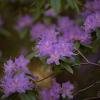March 29, 2007 - 5:00pm
An invasive freshwater alga – sometimes called ‘rock snot’ - is clogging Vancouver Island rivers and local scientist Dr. Max Bothwell is trying to figure out why.
Dr. Bothwell, a freshwater ecologist at Nanaimo’s Pacific Biological Station (PBS) and adjunct professor at Malaspina University-College, will unravel the mystery of this strange alga and describe his research at a free public lecture called “Blooms of Didymosphenia geminata in rivers on Vancouver Island 1990 to present: A sign of environmental change or a new invasive species?”
The presentation on April 4, from 7 to 8 pm at Malaspina's Nanaimo campus, "will appeal to anyone interested in environmental issues and a good mystery,” said Dr. Bothwell, a self-described Sherlock Holmes.
Heavy blooms of Didymosphenia geminata (D. geminata) first began appearing in the Heber River on Vancouver Island near Gold River in 1989. Within five years, blooms spread to 12 rivers in the mid and southern Vancouver Island regions, and became abundant in pristine, nutrient-poor rivers previously known to have very low algal biomass. Almost all rivers in the Nanaimo lowlands were infested with D. geminata blooms in the 1990s, said Dr. Bothwell.
The main concern is that infestation of alga blooms could adversely impact young salmon which spend their first two or three years living in rivers before heading out to sea. Other possible problems include reduced rearing habitat for fish due to changes in invertebrate communities, physical impacts such as gill irritations and clogging, and reduced dissolved oxygen in spawning beds.
Bothwell, who has studied D. geminate growth for more than 20 years, said investigations to determine the environmental cause of the blooms during the early 1990’s proved inconclusive. Studies on the impact of solar ultraviolet radiation on D. geminata growth also failed to find any significant species selective effect.
A surprising breakthrough came in 2004 when he received a call from researchers in New Zealand who reported a similar alga outbreak in freshwater rivers. “Never before had the natural organism appeared outside the Northern Hemisphere,” he said.
“That’s when I began analyzing provincial fishing license data,” he added. “I explored the possibility that D. geminata blooms on Vancouver Island in the 1990s might have resulted from an invasion by a new strain of D. geminata to Island streams associated with intense recreational fishing pressure in the late 1980s.”
Dr. Bothwell believes there may be a connection between the D. geminata and fly fishers who travel the world. There’s some evidence in New Zealand that spores could be transported on the felt soled bottoms of hip waders worn by fly fishers. "But we don't know for sure," he said. "The mystery of how this freshwater alga ended up in Island rivers still hasn't been solved."
Dr. Bothwell has a BA and MA in Biological Oceanography from the University of California-Santa Barbara, and a PhD in Limnology from the University of Wisconsin-Madison. He’s worked as a research scientist with Environment Canada at the PBS since 1997.
His free public lecture, which is part of Malaspina's Faculty of Science and Technology spring lecture series, takes place from 7 to 8 pm in Malaspina's Student Services Building (Bldg. 200, Rm. 203) at the Nanaimo campus. The lecture is sponsored by the Mid-Island Science, Technology and Innovations Council (MISTIC), Natural Sciences and Engineering Research Council (NSERC), Innovation and Development Corporation (IDC) and the Malaspina Faculty Association (MFA) Professional Development Committee. For more information, visit the website at http://web.viu.ca/simmsw/
Tags: In the Community






